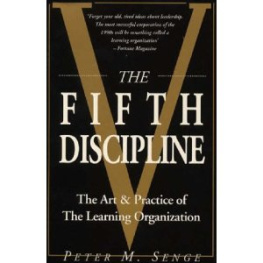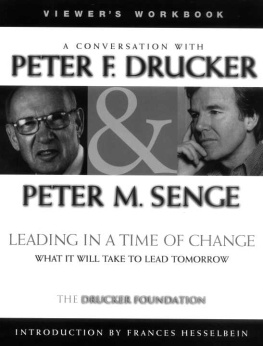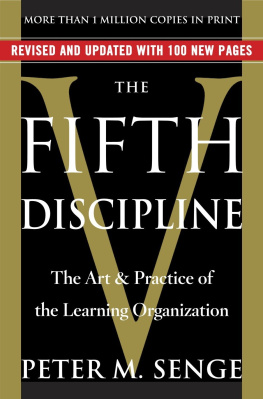Peter M Senge - The Fifth Discipline: The Art and Practice of the Learning Organization
Here you can read online Peter M Senge - The Fifth Discipline: The Art and Practice of the Learning Organization full text of the book (entire story) in english for free. Download pdf and epub, get meaning, cover and reviews about this ebook. year: 2010, publisher: Random House, genre: Business. Description of the work, (preface) as well as reviews are available. Best literature library LitArk.com created for fans of good reading and offers a wide selection of genres:
Romance novel
Science fiction
Adventure
Detective
Science
History
Home and family
Prose
Art
Politics
Computer
Non-fiction
Religion
Business
Children
Humor
Choose a favorite category and find really read worthwhile books. Enjoy immersion in the world of imagination, feel the emotions of the characters or learn something new for yourself, make an fascinating discovery.
- Book:The Fifth Discipline: The Art and Practice of the Learning Organization
- Author:
- Publisher:Random House
- Genre:
- Year:2010
- Rating:4 / 5
- Favourites:Add to favourites
- Your mark:
- 80
- 1
- 2
- 3
- 4
- 5
The Fifth Discipline: The Art and Practice of the Learning Organization: summary, description and annotation
We offer to read an annotation, description, summary or preface (depends on what the author of the book "The Fifth Discipline: The Art and Practice of the Learning Organization" wrote himself). If you haven't found the necessary information about the book — write in the comments, we will try to find it.
Peter M Senge: author's other books
Who wrote The Fifth Discipline: The Art and Practice of the Learning Organization? Find out the surname, the name of the author of the book and a list of all author's works by series.
The Fifth Discipline: The Art and Practice of the Learning Organization — read online for free the complete book (whole text) full work
Below is the text of the book, divided by pages. System saving the place of the last page read, allows you to conveniently read the book "The Fifth Discipline: The Art and Practice of the Learning Organization" online for free, without having to search again every time where you left off. Put a bookmark, and you can go to the page where you finished reading at any time.
Font size:
Interval:
Bookmark:
CONTENTS Introduction to the Paperback Edition ix Some Tips for First-Time Readers xxi PART I HOW OUR ACTIONS CREATE OUR REALITY... AND HOW WE CAN CHANGE IT 1 "Give Me a Lever Long Enough ... and Single-Handed I Can Move the World" 3 2 Does Your Organization Have a Learning Disability? 17 3 Prisoners of the System, or Prisoners of Our Own Thinking? 27 PART II THE FIFTH DISCIPLINE: THE CORNERSTONE OF THE LEARNING ORGANIZATION 4 The Laws of the Fifth Discipline 57 5 A Shift of Mind 68 6 Nature's Templates: Identifying the Patterns That Control Events 93 7 The Principle of Leverage 114 8 The Art of Seeing the Forest and the Trees |
PART III | |
THE CORE DISCIPLINES: | B U I L D I N |
THE LEARNING ORGANIZATION | |
9 Personal Mastery | |
10 Mental Models | |
11 Shared Vision | |
12 Team Learning | |
PART IV | |
PROTOTYPES | |
13 Openness | |
14 Localness | |
15 A Manager's Time | |
16 Ending the War Between Work and Family | |
17 Microworlds: The Technology of the Learning Organization 313 | |
18 The Leader's New Work | |
PART V | |
CODA | |
19 A Sixth Discipline? | |
20 Rewriting the Code | |
21 The Indivisible Whole | |
Appendix 1. The Learning Disciplines | |
Appendix 2. Systems Archetypes | |
Notes | |
Acknowledgments | |
Index |
PART I
How Our Actions Create Our Reality.. and How We Can Change It
"GIVE ME A LEVER LONG ENOUGH...AND SINGLE-HANDED I CAN MOVE THE WORLD"
From a very early age, we are taught to break apart problems, to fragment the world. This apparently makes complex tasks and subjects more manageable, but we pay a hidden, enormous price. We can no longer see the consequences of our actions; we lose our intrinsic sense of connection to a larger whole. When we then try to "see the big picture," we try to reassemble the fragments in our minds, to list and organize all the pieces. But, as physicist David Bohm says, the task is futilesimilar to trying to reassemble the fragments of a broken mirror to see a true reflection. Thus, after a while we give up trying to see the whole altogether.
The tools and ideas presented in this book are for destroying the illusion that the world is created of separate, unrelated forces. When we give up this illusionwe can then build "learning organizations," organizations where people continually expand their capacity to create the results they truly desire, where new and expansive patterns of thinking are nurtured, where collective aspiration is set free, and where people are continually learning how to learn together.
As Fortune magazine recently said, "Forget your tired old ideas about leadership. The most successful corporation of the 1990s will be something called a learning organization." "The ability to learn faster than your competitors," said Arie De Geus, head of planning for Royal Dutch/Shell, "may be the only sustainable competitive advantage." As the world becomes more interconnected and business becomes more complex and dynamic, work must become more "learningful." It is no longer sufficient to have one person learning for the organization, a Ford or a Sloan or a Watson. It's just not possible any longer to "figure it out" from the top, and have everyone else following the orders of the "grand strategist." The organizations that will truly excel in the future will be the organizations that discover how to tap people's commitment and capacity to learn at all levels in an organization.
Learning organizations are possible because, deep down, we are all learners. No one has to teach an infant to learn. In fact, no one has to teach infants anything. They are intrinsically inquisitive, masterful learners who learn to walk, speak, and pretty much run their households all on their own. Learning organizations are possible because not only is it our nature to learn but we love to learn. Most of us at one time or another have been part of a great "team," a group of people who functioned together in an extraordinary way who trusted one another, who complemented each others' strengths and compensated for each others' limitations, who had common goals that were larger than individual goals, and who produced extraordinary results. I have met many people who have experienced this sort of profound teamworkin sports, or in the performing arts, or in business. Many say that they have spent much of their life looking for that experience again. What they experienced was a learning organization.
The team that became great didn't start off greatit learned how to produce extraordinary results.
One could argue that the entire global business community is learning to learn together, becoming a learning community. Whereas once many industries were dominated by a single, undisputed leader one IBM, one Kodak, one Procter & Gamble, one Xeroxtoday industries, especially in manufacturing, have dozens of excellent companies. American and European corporations are pulled forward by the example of the Japanese; the Japanese, in turn, are pulled by the Koreans and Europeans. Dramatic improvements take place in corporations in Italy, Australia, Singaporeand quickly become influential around the world.
There is also another, in some ways deeper, movement toward learning organizations, part of the evolution of industrial society. Material affluence for the majority has gradually shifted people's orientation toward workfrom what Daniel Yankelovich called an "instrumental" view of work, where work was a means to an end, to a more "sacred" view, where people seek the "intrinsic" benefits of work.1 "Our grandfathers worked six days a week to earn what most of us now earn by Tuesday afternoon," says Bill O'Brien, CEO of Hanover Insurance. "The ferment in management will continue until we build organizations that are more consistent with man's higher aspirations beyond food, shelter and belonging."
Moreover, many who share these values are now in leadership positions. I find a growing number of organizational leaders who, while still a minority, feel they are part of a profound evolution in the nature of work as a social institution. "Why can't we do good works at work?" asked Edward Simon, president of Herman Miller, recently. "Business is the only institution that has a chance, as far as I can see, to fundamentally improve the injustice that exists in the world. But first, we will have to move through the barriers that are keeping us from being truly vision-led and capable of learning."
Perhaps the most salient reason for building learning organizations is that we are only now starting to understand the capabilities such organizations must possess. For a long time, efforts to build learning organizations were like groping in the dark until the skills, areas of knowledge, and paths for development of such organizations became known. What fundamentally will distinguish learning organizations from traditional authoritarian "controlling organizations" will be the mastery of certain basic disciplines. That is why the "disciplines of the learning organization" are vital.
DISCIPLINES OF THE LEARNING ORGANIZATION
On a cold, clear morning in December 1903, at Kitty Hawk, North Carolina, the fragile aircraft of Wilbur and Orville Wright proved that powered flight was possible. Thus was the airplane invented; but it would take more than thirty years before commercial aviation could serve the general public.
Next pageFont size:
Interval:
Bookmark:
Similar books «The Fifth Discipline: The Art and Practice of the Learning Organization»
Look at similar books to The Fifth Discipline: The Art and Practice of the Learning Organization. We have selected literature similar in name and meaning in the hope of providing readers with more options to find new, interesting, not yet read works.
Discussion, reviews of the book The Fifth Discipline: The Art and Practice of the Learning Organization and just readers' own opinions. Leave your comments, write what you think about the work, its meaning or the main characters. Specify what exactly you liked and what you didn't like, and why you think so.







